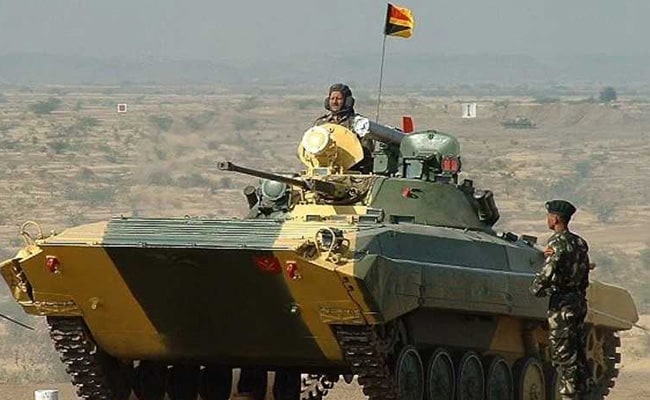Infantry Combat Vehicles (ICVs), also known as Armoured Personnel Carriers, lie at the heart of Indian Army’s operations in any war against Pakistan.

NEW DELHI: If India were to go to war with Pakistan right now, its soldiers would be at risk on a very basic front -the vehicles that carry them into the battlefield are outdated – at least three decades old – and are not equipped with modern night vision devices, a key vulnerability in modern warfare.
Eight years ago, the government cleared the acquisition of more than 2,000 Infantry Combat Vehicles (ICVs) for the army – the deal is worth Rs. 60,000 crore.
But a series of delays and a tangle of red tape have meant that even now, not a single new vehicle has been ordered, let alone entered service. As a result of the delays, the army continues to fight with Russian- designed BMP-2 ICVs, unreliable and prone to technical snags because to keep them running, their engines have been overhauled beyond their prescribed limits.
Documents accessed by NDTV lay out the serpentine process within the Defence Ministry where different wings have been unable to reach a consensus on how the project is to proceed. Worried at the consequences of the delay, G Mohan Kumar, the last Defence Secretary, documented his concerns. In a file noting in April last year, Mr Kumar warned that “raising doubts over the evaluation methodology or changing it at this stage will not be consistent with the established procedure.” His own ministry, he said, was “delaying inordinately [the] acquisition of critical equipment for the army.”
Infantry Combat Vehicles (ICVs), also known as Armoured Personnel Carriers, lie at the heart of the army’s operations in any war against Pakistan. A key element of army combat teams, each ICV carries 10 fully-armed soldiers into the battle-field. ICVs often follow tank formations which are meant to strike dagger-like blows across the border as the army fights deep inside enemy territory. Highly mobile and equipped with anti-tank missiles, ICVs support tank operations and also accompany artillery formations, bridge-laying tanks, and air defence units. They are designed to protect the soldiers they carry within against all small-arms fire but cannot withstand the impact of a tank shell.
The army’s saga to acquire a new Infantry Combat Vehicle began in in October 2009. The new ICVs were to be made in India in a bid to encourage indigenous manufacture of key weapon systems. The army issued an Expression of Interest – which solicits quotes and bids – in 2010 to Tata, Mahindra Defence Systems, Larsen & Toubro and the government-run Ordnance Factory Board.
Then the delays began -and kept piling up. In December 2012, the army’s Expression of Interest was withdrawn because of a reported difference of opinion in how the army’s experts and the Defence Ministry’s team evaluated the proposal that had been submitted by defence manufacturers. Unable to find common ground, the main file on the ICV project was returned to the army four years after the process first began. The instructions given were to wait for a new set of government guidelines meant to specify rules for private sector Indian defence manufacturers. According to a document accessed by NDTV, “This decision was likely to delay the project by another 2 years.”
Under intense pressure from the army which realised that its existing BMP-2 was utterly obsolete, the Defence Ministry agreed to a fresh Expression of Interest in April 2014. 10 Indian companies responded to this following which it took the Defence Ministry another year to decide how it intended to evaluate the prototypes provided by each firm.
Five private firms and the government’s Ordnance Factory Board said they wanted to be considered and the Defence Ministry submitted an evaluation report on each proposal on November 25, 2016.
In late 2016, in perhaps the biggest setback to the ICV project, those reviews or evaluation reports were rejected by the Defence Ministry’s Director General (Acquisitions) because the “the methodology for selection was at variance with [the] Defence Procurement Procedure 2008,” the government manual being used to process this deal.
This recommendation was overruled by Mr Kumar, the Defence Secretary, claiming that “the option of scrapping the present process and issuing a fresh expression of interest may not be in our best interest considering that this will put us back by a few years and render all effort so far made infructuous thus delaying inordinately acquisition of critical equipment for the army.”
He could not have stated the consequences more baldly. Two meetings of the Defence Production Board were held late last year. Since then, one of the firms competing for the order has raised questions about three competitors. With a formal complaint lodged, a panel of independent experts was formed in November. Senior Ministry sources have told NDTV that no decision has been taken on how to proceed with the army’s Infantry Combat Vehicle project.
The phenomenally slow process to clear the acquisition of one of the most basic fighting systems of the Indian Army exemplifies all that is wrong with India’s weapons procurement process. In a classified briefing to Prime Minister Narendra Modi in November last year, Dr Subhash Bhamre, the Minister of State for Defence, said India’s weapons-buying is frequently crippled by “multiple and diffused structures with no single point accountability, multiple decision-heads, duplication of processes, delayed comments, delayed execution, no real-time monitoring, no project-based approach and a tendency to fault-find rather than to facilitate.”
